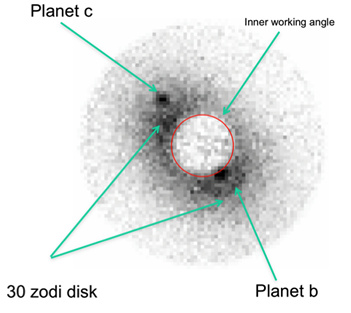WFIRST!
The Wide-Field Infrared Survey Telescope (WFIRST) is a future space telescope to be launched in the mid-2020's. It's about the size of Hubble, but smaller than JWST. But compared to Hubble, WFIRST will be able to image a much larger portion of the sky all at once. WFIRST will help us answers about galaxy formation, dark energy, and not to mention find a bunch of new exoplanets through the microlensing technique.
However, WFIRST will also be equipped with a coronagraphic instrument to direclty image planets. But unlike current direct imaging systems, this one is gonna be beyond awesome! See below:
Direct Imaging with WFIRST

The image on the left is a simulation of what the WFIRST coronagraph mgiht see around the star 47 Ursa Majoris. These are two planets that have already been detected by the radial velocity method, and the simulations show the light from the star reflected off the planets. The brightness of the planets compared to the star is about a billion to 1; something we have not achieved yet! Hopefully these observations with WFIRST (which for each target will be on the order of DAYS!) will help us understand the atmosphere of some of there large Jupiter sized exoplanets! If you're interested in learning about direct imaging and trying to look for lights ACTUALLY coming from a planet, check out my direct imaging page.
WFIRST @ IPAC
IPAC is one of the science centers for the WFIRST mission, tasked with activities related to WFIRST, this includes working closely with the new Science Investigation Teams (SITs). I am helping with tasks related to coronagraph science; to share and host simulation data at IPAC (e.g., astrophysical scenes, albedo spectra) as well as provide an IPAC interface to the planet yield estimator tool, EXOSIMS [paper], by Dimitry Savransky.
More updates to come.
PISCES IFS
One of the instruments that will work alongside the CGI on WFIRST is the PISCES integral field spectrograph (IFS). I will soon be working on data extraction and processing of the IFS testbed and simulated data from the JPL high-contrast imaging testbed (HCIT). Stay tuned.